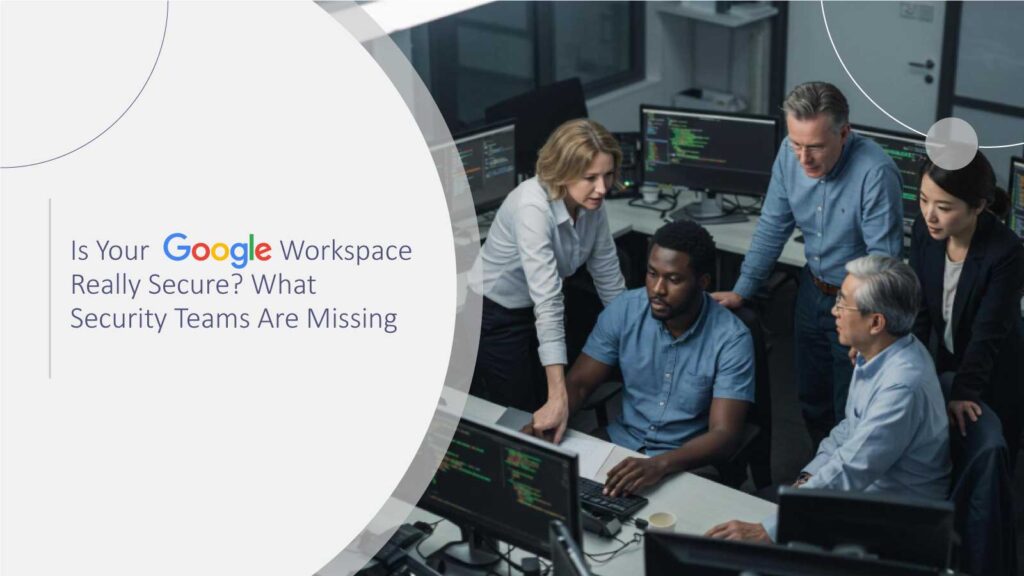You open your Google Workspace dashboard- Gmail, Drive, Chat, Calendar- all humming along. Everything works. It feels safe. But feeling safe is not the same as being safe. Even mature organizations rely on Google Workspace and assume all is well- when in fact critical gaps remain.
In an era where cloud collaboration underpins modern work, many security teams focus on headline risks- zero‑day exploits, state‑sponsored actors- and miss subtler, slower failings: identity mismanagement, uncontrolled sharing, ungoverned apps, configuration drift. These are the cracks that adversaries exploit.
This article explores why Google Workspace isn’t automatically secure, what security teams often overlook, and practical steps to strengthen your posture. By the end, you’ll have concrete takeaways to recall when your board asks: “Are we secure?”
Key takeaways:
- Built-in protections don’t guarantee safety- misconfigurations drive risk.
- Identity, access, and apps matter more in cloud collaboration than classic firewalls.
- Security is continuous, not one-time.
- Balancing productivity and control is critical for compliance.
- Process, awareness, and monitoring matter as much as tools.
Why Google Workspace Isn’t Automatically Secure
Let’s address the elephant in the room. Yes- Google Workspace can be highly secure. The platform includes encryption at rest and in transit, phishing and malware protections, multi-factor authentication (MFA), device management, audit logs, and more. Google itself emphasizes the “shared responsibility” model of cloud security.
Yet- and this is where many teams stumble- that doesn’t mean it is secure for your organization.
Incorrect assumption of “secure by default”
Many administrators assume that because the platform is from a trusted vendor, everything is configured correctly. In practice, advanced features are often disabled or left at permissive settings. Many organizations haven’t enforced key controls like default sharing restrictions or app governance.
Configuration drift and user behaviors
Secure today can become insecure tomorrow. New users, new files, new add-ons- and over time, sharing permissions change, accounts linger, app permissions accumulate. Human error accounts for as much as 88% of data breaches in cloud environments.
Identity & access = the new perimeter
Traditional firewalls and network segmentation matter less in cloud collaboration. Identity, device, and application context are the new perimeter. If a user’s credentials are compromised or an app has broad permissions, exposure is inevitable. Gartner predicts cloud-related incidents will account for over two-thirds of enterprise security investigations by 2027.
According to Gartner, worldwide end‑user spending on information security is projected to reach US $213 billion in 2025, up from US $193 billion in 2024.
Third-party integrations and sharing flows
Users will add Marketplace apps, link external collaborators, and share documents widely. If ungoverned, these create exposure. Many security teams lack visibility into all apps or sharing flows.
The bottom line: adopting Google Workspace should trigger a governance focus, not a “we’re in the cloud, so we’re secure” mindset.
The Hidden Complexity of Cloud Security in Google Workspace
As organizations increasingly rely on Google Workspace for collaboration, the scale and complexity of cloud operations have grown exponentially. According to McKinsey, over 95% of enterprises now have a cloud footprint, and public-cloud workloads have surged from 32% in 2018 to 52% in 2025. Yet, despite rapid adoption, only about 10% of cloud transformations achieve their full value, highlighting a disconnect between cloud usage and secure, optimized implementation.
Security teams face mounting pressure: Gartner predicts that by 2027, over two-thirds of enterprise security investigations will involve cloud or third-party infrastructure. This underscores that cloud-native platforms like Google Workspace, while secure by design, are not automatically secure in practice. Misconfigurations, legacy permissions, and ungoverned third-party applications create an evolving attack surface that grows silently over time. Human error remains a significant factor; studies indicate that up to 88% of cloud-related breaches involve human mistakes, from incorrect sharing to overlooked access rights.
Additionally, the financial stakes are considerable: Gartner projects global cloud security spending to grow 24% in 2024, reflecting the urgency with which enterprises are addressing these risks. McKinsey further notes that organizations that fail to secure cloud environments risk leaving trillions of dollars in business value unrealized, whether through intellectual property loss, operational downtime, or reputational harm. In practical terms, this means that even a platform as robust as Google Workspace requires active governance, continuous monitoring, and disciplined user practices.
Security teams cannot assume that built-in protections alone suffice; they must adopt a proactive posture, regularly audit configurations, and enforce identity, access, and application policies to ensure that productivity does not come at the expense of exposure. Without continuous oversight, even small misconfigurations can cascade into significant breaches, making vigilance not optional but essential.
What Security Teams Are Really Missing
Here are four key areas where organizations commonly fall short:
Identity & Access Management (IAM) Gaps
Imagine a user changes roles but retains original access. Or a contractor’s account remains in a shared folder with external sharing. Or an app service account has broad Editor rights with no quarterly review. These are identity weaknesses.
Key actions:
- Enforce MFA/2-step verification for all accounts.
- Adopt role-based access, cleaning up legacy groups and memberships.
- Automate off-boarding: remove departing users from groups, links, and apps.
- Monitor behavioral anomalies: large downloads, mass external sharing, and unknown devices.
Data Sharing & File Governance
A common exposure: folders set to “Anyone with the link” remain active long after a project ends.
Steps to mitigate:
- Audit “anyone with link” permissions and remove inappropriate access.
- Set default sharing to “Internal only” or “Restricted.”
- Implement data classification and DLP rules.
- Conduct periodic reviews of dormant shared links.
Connected Third-Party Apps & OAuth Exposure
Marketplace apps and OAuth tokens increase risk if granted broad permissions.
Recommendations:
- Maintain a whitelist of approved apps.
- Monitor OAuth token scopes and revoke unused tokens.
- Address shadow IT; prevent users from installing apps without admin oversight.
- Review app vendor status periodically. Human error and misconfiguration cause ~31% of cloud breaches.
More than 95% of enterprise organizations now have a cloud footprint, and public‑cloud workloads rose from 32% in 2018 to 52 % in 2025.
Configuration Drift & Continuous Monitoring
Secure settings today can degrade unnoticed. Exceptions, pilot programs, and temporary changes often persist.
Approach:
- Establish a secure baseline: sharing defaults, MFA, and device management.
- Conduct periodic audits of settings, sharing, and apps.
- Create dashboards for executives highlighting externally shared folders, apps with a broad scope, and inactive accounts with Editor access.
- Document and time-limit exceptions. Gartner notes cloud security spending will grow 24% in 2024.
Practical Steps to Strengthen Google Workspace Security
Rapid Assessment (30-day sprint)
- Identify users without MFA.
- Audit external sharing and Editor-level access.
- List installed Marketplace apps and review their permissions.
- Identify inactive accounts.
- Confirm device management policies.
Enforce the Big Four Controls
- MFA for all accounts.
- Default sharing set to internal.
- App-governance policy: whitelist apps, review OAuth scopes quarterly.
- Enable device management for mobile and BYOD devices.
Ongoing Monitoring & Governance
- Monthly or quarterly audits of sharing, apps, and inactive accounts.
- Reporting for leadership: highlight improvements like reduced external shares.
- User prompts for awareness when sharing externally.
- Alerts for unusual access or mass downloads.
Advanced Risk-Based Measures
- Zero-trust access: treat every session as untrusted until verified.
- Conditional access based on device, location, or behavior.
- Behavior analytics: detect anomalies like bulk downloads.
- Automated remediation: remove or restrict old “anyone with link” shares.
- Data classification with automated enforcement for sensitive content.
Real-World Examples
The Forgotten External Link
A shared Drive folder set to “Anyone with the link” remained live after a project ended. Months later, it appeared in a public blog post.
Lesson: External shares often outlive their purpose. Implement lifecycles or reviews.
The Marketplace App with Broad Scope
A time-tracking app requested access to all Drive files and Gmail. When the vendor was compromised, OAuth tokens persisted.
Lesson: Track app permissions and remove unused apps.
Configuration Drift in Sharing Settings
A pilot remote-work policy temporarily enabled external calendar sharing. Three months later, hundreds of sensitive events were externally visible.
Lesson: Secure settings degrade over time if exceptions aren’t tracked.
Conclusion
Google Workspace has strong protections, but your configuration, users, sharing, and apps define your security. Most gaps lie in identity/access management, sharing governance, third-party apps, and configuration drift. Practical steps include audits, MFA enforcement, app governance, device management, and continuous monitoring.
Remember:
- Assume “not secure” until verified.
- Prioritize identity and file sharing.
- Monitor continuously.
- Enable productivity securely.
- Build governance habits, not just tools.
Ask yourself: What am I doing tomorrow to ensure our Workspace stays secure? And how will I check again in 90 days?
FAQs
Q1: How often should we audit external sharing?
At least quarterly, ideally monthly if high churn occurs.
Q2: Are native Workspace security tools sufficient?
They provide a foundation, but additional monitoring and controls are required for higher-risk environments.
Q3: Should all Marketplace apps be blocked?
No. Implement an app governance policy: whitelist trusted apps, monitor permissions, and remove unused apps.
Q4: How important is device management?
Critical. Unmanaged or compromised devices can bypass strong cloud identity protections.
Q5: How do I get executive support for Workspace security?
Use measurable metrics: external shares, app permissions, and MFA adoption. Highlight exposure reduction and rising cloud security investment.
Don’t let cyber attacks catch you off guard – discover expert analysis and real-world CyberTech strategies at CyberTechnology Insights.
To participate in upcoming interviews, please reach out to our CyberTech Media Room at info@intentamplify.com.


